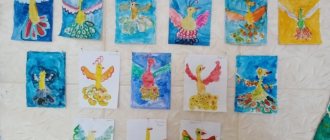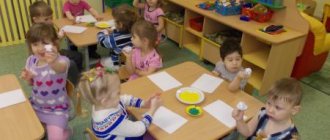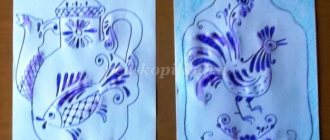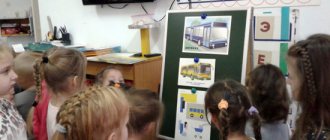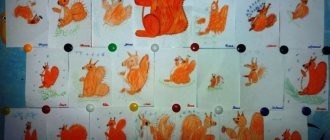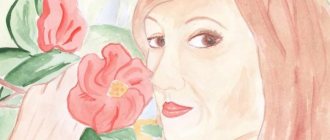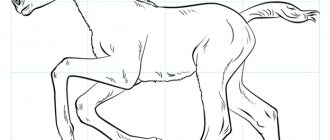Drawing. Lesson notes - Notes on drawing "Matryoshka" (senior group)
Publication "Summary of NOD for drawing "Matryoshka" (senior..." Goal: to continue to develop interest in the aesthetic side of the environment; to satisfy the needs of children in self-expression, the implementation of independent creative (visual) activities. Objectives: Educational: Teach independently, paint blanks of nesting dolls...
Summary of a drawing lesson in the senior group “My favorite toy”
Objectives: to develop creative imagination, the ability to conceive the content of one’s work, the ability to translate one’s ideas on paper, to evaluate one’s own work and the work of other children. Preliminary work: repeating poems by Agniy Barto from the “Toys” series, composing stories on the topic...
Summary of a drawing lesson in the senior group “Let's decorate Alyonushka's clothes with beautiful patterns” Topic title “Let's decorate Alyonushka's clothes with beautiful patterns” The goal is to introduce children to a new way of drawing using a stamp, to consolidate familiar methods and techniques of drawing Objectives Educational: to introduce children to the history of creation and technology performing Russian printed...
Summary of a drawing lesson “The girl is dancing” with children of senior preschool age
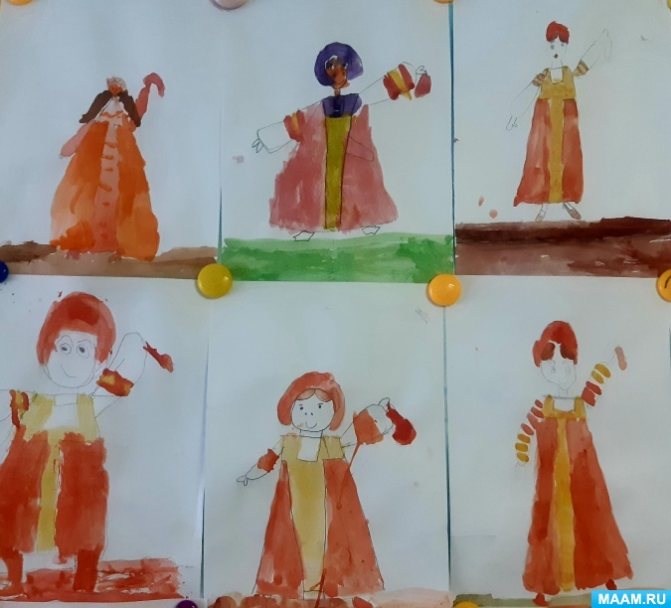
Priority area: Artistic and aesthetic development Integration of educational areas: RR; TFR; FR. Goal: To develop children’s ability to draw a human figure in motion Objectives: Educational: -Teach children to draw a human figure, conveying the simplest relationships in…
Notes on drawing for children of the senior group “Owl-owl, big head”
Summary of GCD on drawing for children of the senior group
"Owl-owl, big head"
Goal: create an image of a bird.
Tasks:
1. Educational:
1.1. cognitive: to form ideas about the diversity of birds, their way of life.
1.2. pictorial: learn to draw a bird, conveying the shape of the body (oval), parts (head, wings, paws, beak), plumage;
1.3. technical: strengthen the skills of drawing with colored pencils and painting images using a variety of strokes, different pressure on the pencil to convey shades of color.
2. Developmental: develop attention, eye, fine motor skills, graphic skills; develop figurative perception and imagination.
3. Educational: to cultivate interest in nature, caring attitude towards our smaller brothers.
Priority educational area: artistic and aesthetic development.
Educational field in integration: cognitive development, speech development.
Organization of a developing subject-spatial environment:
For the teacher: a toy (illustration) of an owl, an audio recording of the owl’s voice.
For children: sheets of white A4 paper, colored pencils and colored wax crayons.
Preliminary work: reading and telling fairy tales: V. Bianchi “The Owl”, D. Kharms “The Tale of the Forgetful Owl”, conversations on them. Examination of illustrations in books with fairy tales and children's encyclopedia. Outdoor games: “Owl-owl, big head”, “Owl”.
GCD move:
Educator: Hello, kids! Now I’ll tell you a riddle, and you try to guess it.
Her eyes are big
The beak of a predator is always hooked.
At night she flies
He sleeps on a tree only during the day.
Children's answers. (Owl).
Educator: That's right, well done!
Shows the children a figurine of an owl and turns on an audio recording with the sounds of the voices of these birds. Draws children's attention to the shape of the owl's body, its large "saucer" eyes, ears with tassels, a small hooked beak and small tenacious legs.
An owl is a bird of prey. It feeds on rodents, which it catches with its claws while flying low above the ground. The huge eyes of an owl do not like daylight, therefore, the owl sleeps during the day and hunts at night. Thanks to its coloring, the owl is a champion in camouflage. In addition, she knows how to retract, pressing her feathers to her body and freezing, thus becoming like a broken branch. Many species of owls are listed in the Red Book.
Guys, now let's play a little!
The outdoor game “Owl-owl, big head” is played.
Educator: Now, guys, let's draw this amazing bird.
Using form-building movements of the hand, he shows how to place the silhouette of a bird on a sheet of paper - large, on the entire sheet. Reminiscent of the shape of the beak, wings, legs.
The children get to work. During the drawing process, the teacher helps the children by asking leading questions about how else to depict its plumage. Reminds you of using different pressure on a pencil to get shades of colors.
At the end of the work, the children look at all the drawings.
Educator: Look what different owls we have: some are mischievous, some are sad, but this one is very menacing! Did you guys like our drawings? Whose drawing did you find more expressive? Why? (Children's answers). Children note the expressiveness of the drawing, careful coloring, the use of different pressure on the pencil, underlining
character of the owl with additional details.
Educator: Well done, guys! Everyone tried very hard. Let's place our drawings at the exhibition so that moms and dads can also admire our owls!
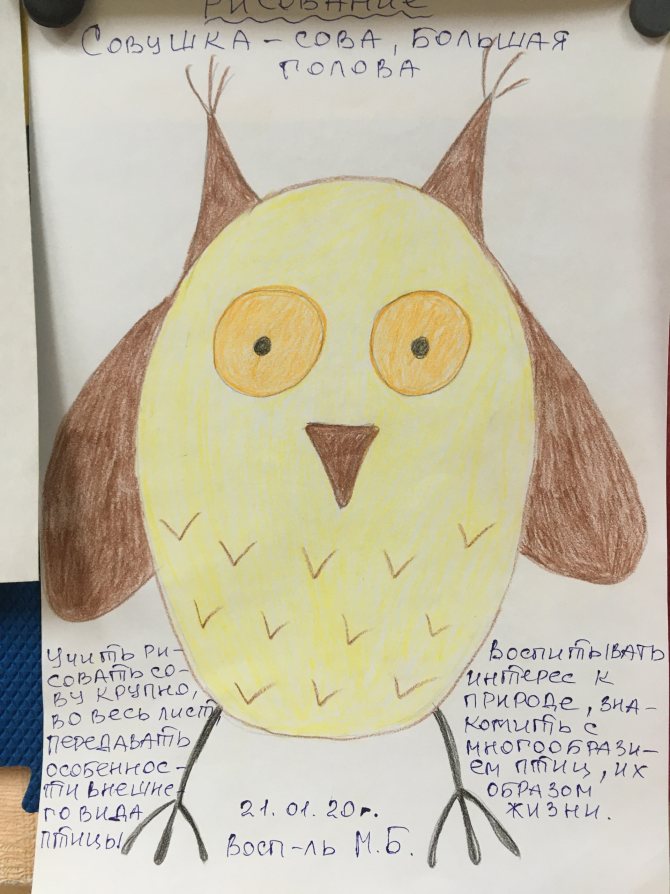
Sample
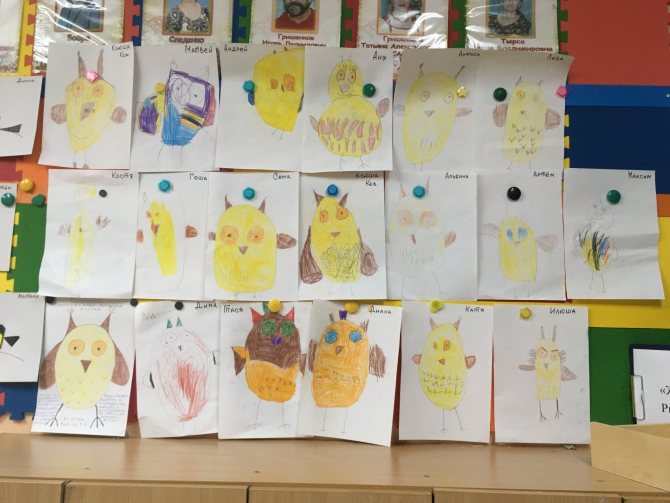
Abstract of GCD on fine art activities in the senior group. Topic “DubY
Summary of a drawing lesson in the senior group
Theme: "Oak"
Program content:
Draw an oak tree, convey its characteristic features (thick trunk, large leaves), introduce shades of green.
Draw a trunk using the “building up” technique, improve the ability to apply strokes by applying the entire bristle of the brush to the paper, consolidate the ability to paint with watercolors, use a palette in accordance with its color properties (transparency).
Develop independence and creativity.
Equipment: watercolor, a jar of water, a jar with thick and thin brushes, a landscape sheet of paper, a palette signed the day before, a napkin.
I a) Conversation
Guys, guess the riddle:
I crawled out of the little barrel, put down roots and grew up, I became tall and powerful, I am not afraid of thunderstorms or clouds. I feed pigs and squirrels - It’s okay that my fruit is small.
What is this? That's right, it's oak. Look, here it is (I open the poster).
In the middle of a huge clearing there is an oak tree. He himself doesn’t remember how old he is, but he knows that there is no one older than him in the forest. Its thick roots go deep into the ground, and its strong branches intertwine with each other and form a huge crown. Birds and animals flock to him from all sides. There is a house and a dining room for them. Although the oak was never alone, he always wanted it to be not the only oak in such a large clearing. Let's help him and draw neighbors for him.
b) Examination of the sample
- Look, this is the kind of oak tree we will draw today (I take out a sample). Where is the oak located? (in the center of the sheet) What does he have? (trunk, branches, crown, leaves) What kind of trunk does it have? (thick). There may be a hollow in the oak trunk, and squirrels can live in it. The oak bark is thick and uneven, with grooves. What color is oak bark? (brown) Where are the branches located? (at the top, on the sides). The branches are thick, gnarled - long and short, there are many of them. Please note that where the branch connects to the trunk, it becomes thicker. Where is the crown located? (above) What color is it? (dark green, different shades of green)
c) Showing the image method
— Look, I’m picking up brown paint, and with the tip of the brush, gradually increasing the pressure, I begin to paint the trunk. At the bottom the trunk expands. Next, I draw one branch, connect it to the trunk, without lifting my hand, I finish drawing the trunk. The trunk becomes thicker. I also draw the next branch, i.e. I am “building up” the trunk. And now Katya will show us how to draw the crown of an oak tree. With each branch the trunk gets thicker and thicker. Tanya will show you how to draw leaves. Come out Tanya and draw. The child draws, and the teacher explains his actions: look, she first took light green paint and “dipped” it on the leaves, and then took dark green paint and painted the leaves with horizontal dabbing with a flat brush. You can show how to mix paint on a palette.
Summary of a lesson on art activities in the senior group
Municipal preschool educational institution "Olenovsky nursery-garden No. 23, Volnovakha district"
Summary of the lesson on visual arts “Tricks of the Blots” (senior group)
Teacher of the highest category
Tseglevka Nina Nikolaevna
Program content:
- expand children's understanding of the variety of colors in the spectrum;
- learn to independently choose image methods according to the plan;
- consolidate the ability to use previously acquired technical skills and abilities in a plot drawing;
- develop children's creative imagination and fantasy;
- cultivate neatness, aesthetic taste, and the ability to complete the work started.
Progress of the lesson
(the group room is decorated with greenery, vines, bright,
colorful soft toys)
Educator:
Guys, do you like to travel? I want to invite you to go to a wonderful, extraordinary country, where you and I will meet old acquaintances, meet and make new friends. And we will go to this country on a ship called...Who can read the name of the ship? (children's answers). That's right, it's called "Rainbow", but only those who correctly name the color in the rainbow and receive an invitation can enter it (children name the colors of the rainbow in the order in which they are: K-O-Z-G-S -F, they receive invitations of different colors and “enter” the ship. The melody of the song “Chunga Changa” sounds)
- What country are we in? Look, guys, how beautiful it is here! And here is the name of this country. (Children read). Yes, that's right, this is Fantasyland. Guys, this country consists of wonderful islands. And here is the first island - the Island of Flowers. You see beautiful flowers (red, blue and yellow). I invite you to gather at the flower that your invitation matches (children must choose their places correctly: red, orange sit on a red flower, yellow and green on a yellow flower, purple, blue and blue on a blue flower).
- The owner of this island is Tsvetik - Multi-colored (a picture appears with the image of a sad multi-colored man). But he's kind of sad today. Here is a box of paints and some kind of letter. Now let's find out what happened? (“reads the letter”)
- Yes, guys, things are not fun. As it turned out, paints now have enemies. The evil Black Blob (a blot appears) stole some colors from the paints. We need to find out which ones and return them to their place. Shall we help the paints? (children are given tasks:
- What color will you get if you mix yellow and blue paints? (green)
- What do you get if you mix blue and red? (violet)
- what if you add white to black? (grey)
the children name the expected colors, the teacher opens them on the palette, and the child at the easel “checks” the correctness of the answers. The blot disappears)
- Well, so we helped the inhabitants of the island of flowers. Tsvetik invites us to another island - the Island of Fairy Tales. (the children sit down at the tables, the Blob appears again. There are black bags on the teacher’s table). Guys, fairy tales live on this island, to which paints gave their names, but I see that the Blob has done its dirty deed here too - it has bewitched all the fairy tales and repainted them black. Let's try to help disenchant them? You need to guess the name from an excerpt from a fairy tale and then the witchcraft spell will dissipate. (Excerpts from fairy tales are read out:
- " Little Red Riding Hood"
- " The Scarlet Flower"
- "Tsvetik - seven-colored"
(as you guess passages from the black bags, books appear). So we corrected the second trick of the Blob. Now the road has led us to the third island - the Island of Creativity. I want to invite you to listen to a new fairy tale, and then we will look at the illustrations for it.
"In the Sweet Carrot Forest"
The hare loved carrots most of all.
He said:
— I would like carrots to grow in the forest instead of fir trees.
The squirrel loved nuts most of all.
She said:
- I would like, Hare, that instead of cones your carrots would grow nuts.
The little bear loved honey most of all.
He said:
— I would like slow honey rains to fall in the fall.
The hedgehog loved dried mushrooms most of all.
He said:
- Let your rains, Little Bear, come after I pick mushrooms.
And that’s how it turned out.
Instead of Christmas trees, carrots grew overnight. The hare cut down two carrots and dragged them to his house.
Nuts grew on the carrot tails. The squirrel collected a whole basket of them and hid them in the hollow of the thickest carrot.
The hedgehog walked between the carrots and picked mushrooms.
And by autumn, slow honey rains began to fall.
The hare ate carrots with honey.
Squirrel – nuts with honey.
Hedgehog – mushrooms with honey.
And Little Bear stood all day long on the carrot edge with his mouth agape, and only when it got dark - just for a little while, just a little bit - after thoroughly licking all four honey paws, he went to bed.
And all the wolves left the forest.
Because wolves don't like sweets...
— Interesting fairy tale? Now let's look at the pictures. (opens the “book”, but there are no pictures in it). This is again the tricks of the Blot. Let's guys make drawings for this fairy tale ourselves and create a book. This will be the first book that we will publish ourselves. (there is a discussion of depiction methods, techniques. Children perform work on the back of a colored or tinted sheet of paper)
- Now we will connect the pages, fasten them to the cover, and we will have our own book, created with our own hands.
Abstract of GCD for drawing “Funny Toys”
Summary of GCD for drawing (drawing along the contour) “Magic toys”
Target:
Develop the ability to trace objects along a contour, starting from a given point.
Tasks:
Educational:
—
Learn to trace objects along a contour, starting from a given point.
—
Continue to learn how to hold a pencil correctly.
- Continue working with four primary colors - red, yellow, green, blue.
Developmental:
Develop attention, visual and motor coordination, fine motor skills.
Educating:
Cultivate an interest in drawing with colored pencils.
Materials and equipment:
Coloring pages with a simple outline of toys, colored pencils, examples of work. Table theater, theater screen.
Nod's move.
Educator:
Hello guys. Do you love fairy tales?
Today I will tell you a fairy tale. Listen.
In one fairy-tale kingdom there lived a King - Pencil. He loved toys very much, and he also loved to walk the streets of his kingdom and distributed pencils to the residents so that they could decorate the walls of their houses with drawings of toys, and also draw pictures. And then he organized holidays, where all the residents had fun and gave each other their works. The residents loved their king very much and gladly accepted gifts from him and drew, painted, painted. And nowhere in the world was there a kingdom more beautiful, brighter, more wonderful and kinder than the kingdom of the King - Pencil.
One day, an evil Sorcerer was jealous of Pencil that his kingdom was very beautiful and made all the residents’ pencils disappear. They could no longer paint their pictures. They had nothing.
The Pencil King became sad and fell ill. The best doctors in the kingdom could not cure him...
Slowly the kingdom lost its bright color and drawings - the toys turned into dots. Even the sun seemed to be shining less, and there were more and more cloudy days.
On one of these cloudy days, one Fairy appeared in the kingdom. She was just flying by. The residents told her about their misfortune.
“Your king will recover if you start drawing pictures again,” said the Fairy.
The residents were surprised and began to think about what they should use to draw, but they couldn’t come up with anything.
Then the fairy offered to defeat the evil sorcerer and return the pencils.
Hooray! - the residents exclaimed. And everyone went to the evil sorcerer. And they didn’t go on foot, but flew by plane.
Physical education minute. Airplane
Hands to the sides - take flight
We're sending the plane
Right wing forward
Left wing forward.
One two three four -
Our plane took off. (Stand legs apart, arms to the sides, turn to the right; turn to the left.)
Sat down - stood up, sat down - stood up
Senior group. Senior preschool age. Children 5-6 years old
Summary of a drawing lesson for the senior group “Snowman” Department of Education of the Nizhny Novgorod City Administration Municipal Autonomous Preschool Educational Institution “Kindergarten No. 37”
(MADOU
"Kindergarten No. 37"
)
Summary of a lesson drawing techniques with children of the senior group 5-6 years old (within the framework of NOD...
Summary of the OOD on drawing with children of the senior group "Day of the Elderly" Municipal budgetary preschool educational institution kindergarten No. 13 combined type Summary of organized educational activities with children of the senior group on artistic and aesthetic development ( drawing )
on the topic
“Older Person’s Day”
Prepared and...
